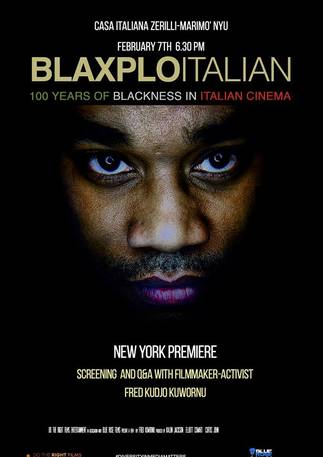


Despite the cold rainy night on February 7th, Casa Italiana Zerilli-Marimò at New York University [2] was jam-packed with excited faces eagerly awaiting the New York premiere screening of Italian-Ghanaian director Fred Kuwornu [3]’s latest documentary, Blaxploitalian: 100 Years of Blackness in Italian Cinema [4]. The film is the first in Casa Italiana’s new series dedicated to debut films from or about Italy. This particular documentary thoroughly examines the experiences and personal struggles of black actors in Italian cinema from 1915 up until present day.
Who is Fred Kuwornu?
The multitalented writer-director-producer-activist is of Ghanaian descent but was born and raised in Italy. After working with the influential film director Spike Lee [5] in Miracle at St. Anna [6], Kuwornu went on to do his own in-depth investigative reports. His prior works include Inside Buffalo [7], which tells the widely unknown story of the segregated African American combat unit that fought in World War II, and 18 Ius Soli [8], an explanation of the Italian law that denies the citizenship to children born of immigrants in Italy. Kuwornu strikes once again with Blaxploitalian, a film that sheds a light not only on social injustices but on a more problematic global phenomenon.
Blaxploitation to Blaxploitalian
The interesting title is a callback to the term “blaxploitation,” the exploitation of black people especially in regard to stereotypical movie roles. The word also refers to the ethic subgenre of popular movies made during the 1970’s in the United States. While interweaving his own personal history into the narrative, Kuwornu takes us on a journey back to when the first black actor appeared in an Italian film in 1915 (although the actor’s name did not appear in the credits) to the experiences of contemporary performers who constantly struggle to find respectable and significant roles.
This multi-layered analysis of black representation in Italian and American cinema includes insightful interviews with actors who are always forced to question their identity. Even though these performers are 100% Italian they are told that they are not Italian enough for leading roles, which almost exclusively leaves them with the parts of foreigners, maids, prostitutes, and criminals.
A Conversation at Casa Italiana
Following the screening of the documentary, there was a discussion with the filmmaker led by the director of Casa Italiana Stefano Albertini [9] and the Chair of the NYU Department of Italian Studies David Forgacs [10]. Kuwornu pointed out that this is not just an Italian problem, citing the “OscarsSoWhite” hashtag that was trending in reaction to the 2016 Academy Awards, nor is it just an African-American problem because other minority groups have even less representation in the film industry.
Blaxploitalian asks its viewers to join the cause in challenging worldwide mainstream filmmakers and audiences into calling for an enhancement and practicing of ethnic and racial diversity in casting for important roles within the international media industries. Kuwornu’s next stop will be at the Italian Cultural Institute of Los Angeles [11] where another screening and Q&A will be held on February 16th.
Source URL: http://test.casaitaliananyu.org/magazine/focus/art-culture/article/blaxploitalian-100-years-blackness-in-italian-cinema
Links
[1] http://test.casaitaliananyu.org/files/blaxploitalian5jpg
[2] http://www.casaitaliananyu.org/
[3] http://www.imdb.com/name/nm2295617/
[4] http://www.imdb.com/title/tt4056422/?ref_=nm_flmg_prd_1
[5] https://en.wikipedia.org/wiki/Spike_Lee
[6] https://en.wikipedia.org/wiki/Miracle_at_St._Anna
[7] http://www.imdb.com/title/tt1576693/?ref_=nm_flmg_prd_3
[8] http://www.imdb.com/title/tt6217762/?ref_=nm_flmg_prd_2
[9] http://www.casaitaliananyu.org/content/stefano-albertini-il-direttore
[10] http://italian.as.nyu.edu/object/faculty_italian_forgacs.html
[11] http://www.iiclosangeles.esteri.it/iic_losangeles/en/gli_eventi/calendario/2017/02/blaxploitalian-cent-anni-di-afrostorie.html